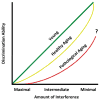Spatial discrimination deficits as a function of mnemonic interference in aged adults with and without memory impairment
- PMID: 24167060
- PMCID: PMC3968903
- DOI: 10.1002/hipo.22224
Spatial discrimination deficits as a function of mnemonic interference in aged adults with and without memory impairment
Abstract
It is well established that aging is associated with declines in episodic memory. In recent years, an emphasis has emerged on the development of behavioral tasks and the identification of biomarkers that are predictive of cognitive decline in healthy as well as pathological aging. Here, we describe a memory task designed to assess the accuracy of discrimination ability for the locations of objects. Object locations were initially encoded incidentally, and appeared in a single space against a 5 × 7 grid. During retrieval, subjects viewed repeated object-location pairings, displacements of 1, 2, 3, or 4 grid spaces, and maximal corner-to-opposite-corner displacements. Subjects were tasked with judging objects in this second viewing as having retained their original location, or having moved. Performance on a task such as this is thought to rely on the capacity of the individual to perform hippocampus-mediated pattern separation. We report a performance deficit associated with a physically healthy aged group compared to young adults specific to trials with low mnemonic interference. Additionally, for aged adults, performance on the task was correlated with performance on the delayed recall portion of the Rey Auditory Verbal Learning Test (RAVLT), a neuropsychological test sensitive to hippocampal dysfunction. In line with prior work, dividing the aged group into unimpaired and impaired subgroups based on RAVLT Delayed Recall scores yielded clearly distinguishable patterns of performance, with the former subgroup performing comparably to young adults, and the latter subgroup showing generally impaired memory performance even with minimal interference. This study builds on existing tasks used in the field, and contributes a novel paradigm for differentiation of healthy from possible pathological aging, and may thus provide an avenue for early detection of age-related cognitive decline.
Keywords: hippocampus; interference; neurocognitive aging; pattern separation; spatial discrimination.
Copyright © 2013 Wiley Periodicals, Inc.
Conflict of interest statement
Figures






References
-
- Bakker A, Kirwan CB, Miller M, Stark CEL. Pattern separation in the human hippocampal CA3 and dentate gyrus. Science (New York, NY) 2008;319(5870):1640–2. Retrieved from http://www.pubmedcentral.nih.gov/articlerender.fcgi?artid=2829853&tool=p.... - PMC - PubMed
-
- Braak H, Braak E. Evolution of the neuropathology of Alzheimer’s disease. Acta neurologica Scandinavica Supplementum. 1996;165:3–12. Retrieved from http://www.ncbi.nlm.nih.gov/pubmed/8740983. - PubMed
-
- Braak H, Braak E, Bohl J. Staging of Alzheimer-related cortical destruction. European Neurology. 1993;9(Suppl 1)(6):257–261. discussion 269–272. Retrieved from http://www.ncbi.nlm.nih.gov/entrez/query.fcgi?cmd=Retrieve&db=PubMed&dop.... - PubMed
Publication types
MeSH terms
Grants and funding
LinkOut - more resources
Full Text Sources
Other Literature Sources
Medical

